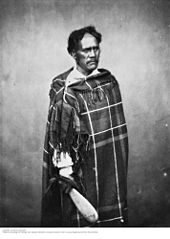Rangatira

In Māori culture Rangatira (Māori pronunciation: [ɾaŋatiɾa]) are the hereditary Māori leaders of hapū, or chieftains. Ideally, rangatira were people of great practical wisdom who held authority on behalf of the tribe and maintained boundaries between a tribe's land and that of other tribes. Changes to land ownership laws in the 19th century, particularly the individualisation of land title, undermined the position of rangatira, as did the widespread loss of land under the colonial government.
Etymology[]
The word "rangatira' means "chief (male or female), wellborn, noble" and derives from Proto-Central Eastern Polynesian *langatila ("chief of secondary status").[1] Cognate words are found in Moriori, Tahitian, Cook Islands Māori, Tuamotuan, Marquesan and Hawaiian.[citation needed]
Interpretations[]

Three interpretations of rangatira consider it as a compound of the Māori words "ranga" and "tira". In the first case, "ranga" is devised as a sandbar and the "tira" a shark fin. The allegoric sandbar helps reduce erosion of the dune (or people). The fin reflects both the appearance of the sandbar, and, more importantly, "its physical and intentional dominance as guardian"(Gray-Sharp, 2011, p. 195).[2] Rangatira reinforce communities, cease to exist without them ("for what is a sandbar without sand?"), and have a protective capacity.[3]
Ethnographer John White (1826-1891) gave a different viewpoint in one of his lectures on Māori customs.[4] He said Māori had traditionally formed two kahui who came together to discuss history or whakapapa.
- "Each chief in the kahui had his place assigned to him, according to the amount of knowledge he possessed; and this place was given to him by the leader of the kahui of which he was a member. This act of the leader was called ranga, or putting in order. The people, as they came to the temple in a body, were called tira, or company; and as the leader had to assign, or ranga, a place to each of his tira, he was called the rangatira, from which we derive our word in Maori for chief, rangatira."[4]
This interpretation fits well with a second translation where "ranga" is an abbreviation of rāranga (or weaving) and "tira" signifies a group.[3]
A third interpretation fits equally well with this translation, interlinking concepts related to the identity of the ‘tira’. In the first instance, the conditional hospitality[5][6][7] presented in the form of weaving created for the ‘tira’ of guests. In the second instance, the collective intentionality[8][9] "enacted in the weaving" of the ‘tira’ of hosts.[10] Together, these concepts highlight the value attached to the "personal relationship" between the leader and their group.[10] This type of relationship is similar to the mahara atawhai (endearment or "benevolent concern") offered in the Treaty of Waitangi’s preamble by Queen Victoria, reflecting the pre-nineteenth century "personal bond between the ruler and subject" (McHugh, 1991, p. 177).[11]
References[]
- ^ Adams, T.; Benton, R.; Frame, A.; Meredith, P.; Benton, N.; Karena, T. (2003). "Te matapunenga: A compendium of references to concepts of Maori customary law" (PDF). The University of Waikato. p. 15.
- ^ Gray-Sharp, K (2011), "Ō rātou kāinga: Tino rangatiratanga and contemporary housing policy", in Tawhai, V MH; Gray-Sharp, K (eds.), Always speaking: The Treaty of Waitangi and public policy, Wellington, New Zealand: Huia, pp. 191–212, ISBN 9781869694814
- ^ Jump up to: a b Gray-Sharp (2011, p. 195).
- ^ Jump up to: a b White, J. (1826–1891). An epitome of official documents relative to Native affairs and land purchases in the North Island of New Zealand. Lectures on Maori Customs, &c., by Mr. John White, Part 11. NZETC, retrieved 13 November 2001.
- ^ Derrida, J. (2000). Of hospitality (R. Bowlby, Trans.). Stanford, CA: Stanford University Press.
- ^ Bell, A. (2010). "Being 'at home' in the nation: Hospitality and sovereignty in talk about immigration". Ethnicities. 10 (2): 236–256. doi:10.1177/1468796810361653.
- ^ Westmoreland, M. W. (2008). "Interruptions: Derrida and hospitality" (PDF). Kritike. 2 (1): 1–10. doi:10.3860/krit.v2i1.566.
- ^ Searle. J. R. (1990). Collective intentions and actions. In P. R. Cohen, J. Morgan, & M. E. Pollack (Eds.), Intentions in communication (pp. 401–416). Cambridge, MA: MIT Press.
- ^ Tuomela, R. (2003). "Collective acceptance, social institutions, and social reality". American Journal of Economics and Sociology. 62 (1): 123–165. doi:10.1111/1536-7150.t01-1-00005.
- ^ Jump up to: a b Gray-Sharp (2011, p. 196).
- ^ McHugh, P. G. (1991). The lawyer’s concept of sovereignty, the Treaty of Waitangi, and a legal history for New Zealand. In W. Renwick (Ed.), Sovereignty & indigenous rights: The Treaty of Waitangi in international contexts (pp. 170–189). Wellington, New Zealand: Victoria University Press.
- Māori words and phrases
- Māori tribal leaders
- Polynesian titles